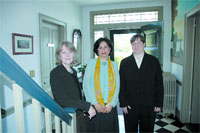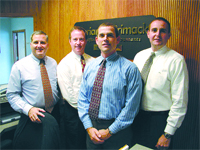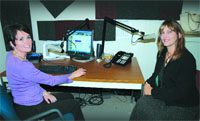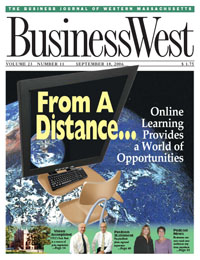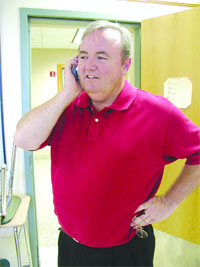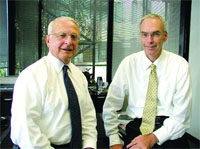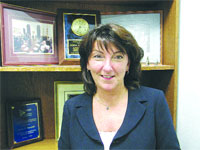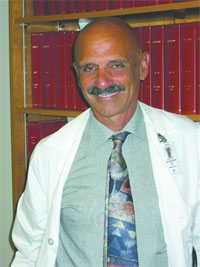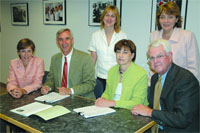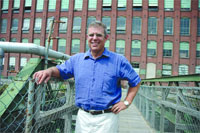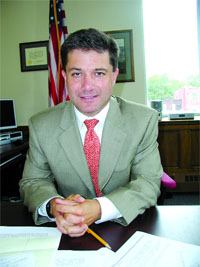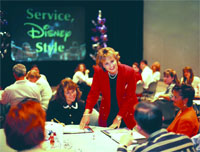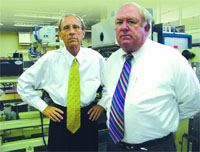Faced with a shortage of qualified machinists that is hindering their growth and endangering their future, area precision machine shop owners are coming together in a unified effort to put more workers in the pipeline. Called RENEW (Regional NetWorks), the 18-month project that began late this spring is designed to build the capacity and profile of that sector, making it a workforce development and economic development initiative
Jack Mitchell finds it hard to comprehend why the precision manufacturing industry has an image problem, one that makes it a relatively hard sell to today’s career seekers.
Actually, he knows the reason. Simply put, people — meaning young students, their parents, many high school guidance counselors, and even some in the business and economic development community — can’t see what he sees.
As owner of Mitchell Machine in Springfield, a third-generation business that manufactures machines used to make everything from saw blades to semi conductors, he sees his 35 employees engaged in challenging, exciting work that is different from week to week if not day to day. The wages and benefits are good, the working conditions are as clean as some restaurants’, and the long-term future remains bright; the work being done at Mitchell’s Hancock Street facilities cannot be sent offshore because the standards for quality are too high, and that scenario won’t change anytime soon.
The story is the same in many of the precision shops in Western Mass., said Mitchell, noting quickly that the problem for this sector is making people know and understand these things and ultimately believe in this industry and its future.
And that’s one of the reasons why Mitchell and others in this sector pushed hard for a $150,00 grant from the John Adams Innovation Institute, which was awarded jointly this past spring to the Hampden County Regional Employment Board (REB) and the local chapter of the National Tooling and Machining Assoc. (NTMA).
The charge is quite specific: develop strategies to put more individuals in the machining pipeline, and the grant calls for the hiring of a sectoral manager to oversee a project called RENEW, an acronym for Regional NetWorks, which addresses that issue.
That job belongs to David Cruise, former human resources director for the Springfield public school system who has taken on other projects for the REB since his retirement from that post. He started his latest assignment by doing large amounts of looking and listening.
Indeed, he’s visited nearly 30 area shops of various sizes, as well as vocational schools and community colleges, to gain some perspective of the scope of the problem and ways to attack it. While compiling data, Cruise is also crafting strategies for creating additional capacity within the precision machining sector.
A Web site is being developed, and an informational DVD will be created and sent to area schools. Open houses at area companies and vocational schools will be scheduled, and a machine tool technology fair is being blueprinted. These tactics and more will be utilized to increase enrollment at area tech schools, improve graduation rates, and, ultimately bring more qualified machinists to the market.
A comprehensive, multi-pronged approach will be necessary, said Cruise, because statistics show both promise for the industry and general indifference toward it on the part of young people and their parents. This translates into a broad disconnect.
To eliminate it, RENEW, an 18-month initiative, will create what its name suggests — a network that will work to create a stronger workforce, a “sustainable pipeline,” as Cruise called it, for the short and long term.
Shop Talk
As he talked with BusinessWest about conditions within his sector, and especially at his shop, Mitchell stopped at a 100-foot-long machine being built to exacting specifications for a Holyoke company that produces disposable blood pressure cuffs.
“This is what we do here,” he said, sweeping his arm across the full breadth of the machine to show the various steps — and technology — involved with turning raw materials into a medical device. “We take a client’s concept, and its problems, and come up with solutions.”
The highly specialized work has kept the doors open at Mitchell for 85 years, he said, and there would seem to be little on the horizon that would prevent them from staying open or hinder the company’s growth potential — except what is now described as an acute shortage of qualified machinists in this market and others.
“It’s always been very difficult to find qualified people to do the work we want to do here,” he explained, adding that the company conducts considerable training designed to “turn machinists into machine builders,” and has benefited greatly from state Workforce Training grants received in recent years.
But merely finding people the company can train is becoming a stern challenge, said Mitchell, noting that he and others in the NTMA are looking for ways to build awareness and enthusiasm for the sector — and they know it’s a tall order.
That’s why the group enthusiastically pursued the John Adams grant, and why Mitchell and others pushed the REB to hire Cruise, a workforce development veteran, for the sectoral manager’s position.
“Good people are the lifeblood of this industry,” said Mitchell. “If we don’t have people in the pipeline, we can’t exist.”
To “develop a series of programs and systems that will enable educators, parents, and students to recognize the viability of high technology precision machining as a career-directed, financially rewarding profession.”
That’s what it says in a revised draft, dated July 26, of the scope of work for the Regional Networks’ education and awareness program. In other words, said Cruise, the task at hand is to build the profile and capacity of the precision industry in the Pioneer Valley.
The tactics to be employed for this assignment include various methods of delivering the message, including the Web site, DVD, and open houses. But the main vehicle for getting the job done will be partnerships — between employers and educators, elected officials, guidance counselors, and chamber of commerce directors. Through such partnerships, a story in need of telling can be effectively told.
Cruise cited recent survey results showing that, despite widespread doubts about the future of manufacturing in the Pioneer Valley and across the country, there is reason for optimism. Indeed, 43% of the local companies queried said they’re experiencing increasing sales, while 37% have increased their market share, 40% have national and international markets, and 69% plan to invest in expansion and new equipment.
At the same time, however, 80% of these companies expressed concern about an aging workforce and lack of a pipeline for new employees, while 69% reported recruitment problems for both skilled and unskilled labor, with a particular focus on skilled machinists and engineers, and 24% reported unfilled positions and growing employment needs.
On the surface, the responses to the second set of questions make little sense given the answers to the first, said Cruise, adding that this phenomenon would clearly indicate that he and the NTMA must do much more than throw a lot of numbers about the precision machining sector at seventh and graders and their parents and invite them to an open house.
This sentiment is verified by enrollment statistics for the machine tool technology programs at the region’s four vocational/technical high schools — Dean Technical, Pathfinder, Westfield Voc/Tech, and Chicopee Comprehensive (a fifth program at Putnam Vocational in Springfield is temporarily closed. The operating programs have total capacity of 230, but enrollment in 2006 was merely 162, while projected enrollment is 203 for this fall, better but still more than 10% under capacity. Meanwhile, those schools graduated only 28 students this spring, indicating a problematic dropout rate.
Developing strategies for putting more students in the classrooms and behind the machines — and keeping them in school — will be one of RENEW’s many goals.
Showing Their Metal
Cruise brings a diverse background in human resources, education, workforce development, and consulting to his current assignment. His most recent work came as a consultant to the REB for the Literacy Works of Hampden County initiative. Prior to that, he did some consulting work for the National Assoc. for Community College Entrepreneurship (NACCE) located at the Andrew M. Scibelli Enterprise Center at STCC.
He retired from the Springfield school system after 18 years and several different titles, including director of Human Resources, chief operations officer, director of Personnel, and director of Occupational Education. Prior to that, he served as director of the Mass. Career Development Institute for six years. Among his many responsibilities there, he directed program operations for career development and employment retraining, and also worked with employers to identify market demands and develop training programs to respond to them.
He will call on much of that experience as he goes about building the linkages considered vital to the overall success of RENEW. These linkages will take place at several points in the educational continuum and will involve students, parents, players in the industry, and administrators at area middle and high schools and community colleges.
The goal is to link students and parents with technology programs in area schools through various communication vehicles, and also to link precision machining companies and educational institutions along the Knowledge Corridor to develop what Cruise calls a “coordinated regional workforce development system” that responds to the changing technological demands of the industry by creating a sustainable pipeline of future workers in that sector.
Cruise said his work with RENEW will be similar in some ways to the REB’s literacy initiative. “There, we focused on creating awareness of the issue,” he said, “looking at existing programs and identifying strengths, weaknesses, gaps, and responses to the gaps.”
With regard to the precision machining sector, the obvious strength is the sectors itself, its depth, and its worldwide reputation. Weaknesses and gaps include limited awareness of the cluster and its seemingly bright future as well as an apparent shortage of programs to train individuals for work in the field.
Indeed, while the area schools are not running at full capacity, if they did, perhaps only another few dozen individuals would graduate each spring.
“That’s not going to be enough, certainly,” said Mitchell, “but 60 is a lot better than 28.”
Thus, Cruise has two immediate challenges — creating more slots at area schools and generating enthusiasm among young people to earn one of them.
Concerning the former, he had talks with Springfield school officials about restarting the program at Putnam — it closed a year ago, and state regulations stipulate that once a program shuts down it cannot reopen for two years. At the very least, Cruise and NTMA members want to make sure that a machine tool technical program is part of plans for a new Putnam, construction of which is slated to start in a few years.
As for drawing people to these programs, Cruise and Mitchell said the message must be sent early — to people in seventh or eighth grade or even earlier — and sent often. An effective Web site focused on the NTMA will be an integral part of this effort, they said, noting that the site now in the development stage will include information, a comprehensive section on career opportunities, and links to area companies and schools.
“We want the Web site to be a destination for parents, students, and educators,” said Cruise. “It’s going to be a big part of our work to make sure the story is told.”
Part and Parcel
Looking down the road about 15 months, Cruise told BusinessWest he’s not sure how many measurable signs of progress there will be when it comes to RENEW’s goals and basic mission. After all, it will take years, perhaps a decade or more before there will be a considerably larger flow of workers in the pipeline.
He expects that there will be some noticeable improvement in the enrollment numbers at area technical high schools, perhaps some progress in reopening the closed program at Putnam, and many new methods of communicating with individuals about the promise of the precision machining industry.
All these steps are keys to securing a long-term future for this sector — a process that begins by enabling more people to see what Jack Mitchell sees.
George O’Brien can be reached at[email protected]



